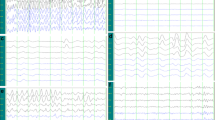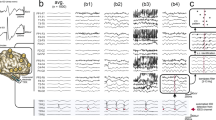Déjà vu (DV) – is an aberration of mental activity associated with the perception of surrounding reality with the impression that unknown objects, new contexts, and people seen for the first time are for some moments perceived as familiar. The aim of the present work was to study the EEG characteristics of the DV phenomenon in epilepsy. A total of 166 subjects took part in the study; subjects were 25.17 ± 9.19 years old and 63.2% were women. The déjà vu phenomenon was compared in groups of healthy subjects (139 subjects) and epilepsy patients (27 cases). Patients were interviewed regarding the characteristics of DV and underwent prolonged (12–16 h) ambulatory EEG monitoring. On the EEG, the phenomenon of DV was characterized by onset with multispike activity in the right temporal leads and, in some cases, ended with slow-wave θ–δ activity in the right hemisphere.
Similar content being viewed by others
References
P. N. Vlasov and A. V. Chervyakov, “Significance of the phenomenon of déjà vu in healthy subjects,” Nevrol. Neiropsikh. Psikhosomat., No. 2, 53–57 (2009).
P. N. Vlasov, A. V. Chernyakov, S. V. Urakov, and A. A. Lukshina, “Diagnostic significance of the phenomenon of déjà vu in the clinical aspects of brain tumors,” Annaly Klin. Eksperim. Nevrol., No. 3, 26–31 (2011).
T. A. Dobrokhotova, S. V. Urakov, and T. A. Chebysheva, “Mental disorders in tumors of the cerebral hemispheres,” in: Neuropsychiatry, Binom, Moscow (2006), pp. 107–131.
V. A. Karlov, “Current concepts in the treatment of epilepsy,” Zh. Nevrol. Psikhiat., 9, No. 5, 4–7 (1999).
N. Adachi, N. Koutromanidis, R. D. C. Elwes, et al., “Interictal 18FDG PET findings in temporal lobe epilepsy with déjà vu,” J. Neuropsych. Clin. Neurosci., No. 11, 380–386 (1999).
N. Adachi, N. Akanuma, M. Ito, et al., “Two forms of déjà vu experiences in patients with epilepsy,” Epilepsy Behav., 18, No. 3, 218–222 (2010).
J. Bancaud, R. Burnet-Bourgin, P. Chanvel, and E. Hargren, “Anatomical origin of déjà vu and vivid ‘memories’ in human temporal lobe epilepsy,” Brain, 117, 71–91 (1994).
F. Bartolomei, E. Barbeau, M. Gavaret, et al., “Cortical stimulation study of the role of rhinal cortex in déjà vu and reminiscences of memories,” Neurology, 63, No. 5, 858–864 (2004).
M. Brazdil, R. Marecek, T. Urbanek, et al., “Unveiling the mystery of déjà vu: The structural anatomy of déjà vu” Cortex, No. 1, 1–4 (2012).
A. S. Brown, “A review of the déjà vu experience,” Psychologic Bull., 129, 394–413 (2003).
J. Engel, Jr., “The timing of surgical intervention for mesial temporal lobe epilepsy: a plan for a randomized clinical trial,” Arch. Neurol., 56, 1338–1341 (1999).
E. Guedja, S. Aubert, A. McGonigal, et al., “Déjà vu in temporal lobe epilepsy: Metabolic pattern of cortical involvement in patients with normal brain MRI,” Neuropsychologia. 48, No. 7, 2174–2181 (2010).
A. Palmini and P. Gloor, “The localizing value of auras in partial seizures: a prospective and retrospective study,” Neurology, 42, 801–808 (1992).
J. Spatt, “Déjà vu: Possible parahippocampal mechanisms,” J. Neuropsychiatry Clin. Neurosci., 14, 6–10 (2002).
P. Striano, A. Gambardella, A. Coppola, et al., “Familial mesial temporal lobe epilepsy (FMTLE): a clinical and genetic study of 15 Italian families,” J. Neurol., 255, 16–23 (2008).
P. Striano, G. Busolin, L. Santulli, et al., “Familial temporal lobe epilepsy with psychic auras associated with a novel LGI1 mutation,” Neurology, 76, No. 13, 1173–1176 (2011).
Y. Takeda, T. Kurita, K. Sakurai, et al., “Persistent déjà vu associated with hyperperfusion in the entorhinal cortex,” Epilepsy Behav., 21, No. 2, 196–199 (2011).
W. van Paesschen, M. D. King, J. S. Duncan, and A. Connelly, “The amygdala and temporal lobe simple partial seizures: a prospective and quantitative MRI study,” Epilepsia, 42, 857–862 (2001).
C. Warren-Gash and A. Zeman, “Déjà vu,” Practical Neurology, No. 3, 1060–109 (2003).
Author information
Authors and Affiliations
Corresponding author
Additional information
Translated from Zhurnal Nevrologii i Psikhiatrii imeni S. S. Korsakova, Vol. 113, No. 4, Iss. II, Epilepsy, pp. 3–9, April, 2013.
Rights and permissions
About this article
Cite this article
Vlasov, P.N., Chervyakov, A.V. & Gnezditskii, V.V. Electroencephalographic Characteristics of the Déjà Vu Phenomenon. Neurosci Behav Physi 44, 754–760 (2014). https://doi.org/10.1007/s11055-014-9979-1
Published:
Issue Date:
DOI: https://doi.org/10.1007/s11055-014-9979-1




